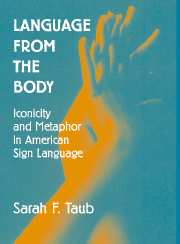Book contents
- Frontmatter
- Contents
- List of Figures
- Acknowledgments
- 1 A Glimpse of the Material
- 2 Motivation and Linguistic Theory
- 3 Iconicity Defined and Demonstrated
- 4 The Analogue-Building Model of Linguistic Iconicity
- 5 Survey of Iconicity in Signed and Spoken Languages
- 6 Metaphor in American Sign Language: The Double Mapping
- 7 Many Metaphors in a Single Sign
- 8 The Vertical Scale as Source Domain
- 9 Verb Agreement Paths in American Sign Language
- 10 Complex Superposition of Metaphors in an American Sign Language Poem
- 11 The Future of Signed-Language Research
- Appendix 1 Glossing Conventions
- Appendix 2 Translation of “The Treasure”
- References
- Index
11 - The Future of Signed-Language Research
Published online by Cambridge University Press: 16 October 2009
- Frontmatter
- Contents
- List of Figures
- Acknowledgments
- 1 A Glimpse of the Material
- 2 Motivation and Linguistic Theory
- 3 Iconicity Defined and Demonstrated
- 4 The Analogue-Building Model of Linguistic Iconicity
- 5 Survey of Iconicity in Signed and Spoken Languages
- 6 Metaphor in American Sign Language: The Double Mapping
- 7 Many Metaphors in a Single Sign
- 8 The Vertical Scale as Source Domain
- 9 Verb Agreement Paths in American Sign Language
- 10 Complex Superposition of Metaphors in an American Sign Language Poem
- 11 The Future of Signed-Language Research
- Appendix 1 Glossing Conventions
- Appendix 2 Translation of “The Treasure”
- References
- Index
Summary
OUR PAST
Since Stokoe's (1960) first bold article proclaiming that signing had linguistic structure, the field of sign language research has grown immensely and gone through a number of stages. Following Newport (1996), I wish to summarize our progression and list some key issues that we as a group have not been addressing. I believe that truly addressing these issues will transform sign linguistics, and the field of linguistics as a whole, by requiring us to handle linguistic motivation, iconicity, and metaphor.
The earliest signed-language research focused on proving that ASL (and soon thereafter, other signed languages) was a true language, with the same types of structure to be found in spoken languages. Researchers sought to counter the myths that signing is a single, universally understood system, or that it is “just pictures” on the hands; that it is “broken English,” or not capable of describing abstractions.
Some linguists, particularly the earliest ones, marveled at the differences between ASL and spoken languages. For example, Stokoe's first description of ASL's form component was called cherology, after the Greek word cheir, or “hand.” It emphasized the simultaneous nature of signs, in which the formational components of handshape, location, and movement occur in a simultaneous package; by contrast, spoken-language components – vowels, consonants, glides, and so on – occur in a sequence.
Later sign linguists sought to minimize those differences.
- Type
- Chapter
- Information
- Language from the BodyIconicity and Metaphor in American Sign Language, pp. 222 - 231Publisher: Cambridge University PressPrint publication year: 2001



